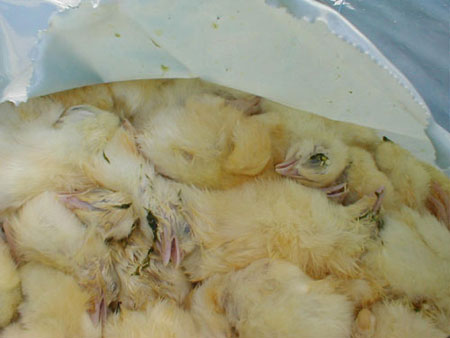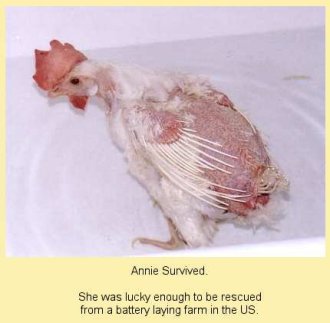Adults in make-believe bunny suits … candy hidden in pastel plastic eggs … baskets overflowing with shiny polymer grass and marshmallow chicks.It’s Easter again! And half the fun is the outrageous synthetic vibrancy of the whole spectacle. But for all the holiday’s up-beat, day-glow artificiality, part of the secular tradition has very real implications for one of its central icons. I’m talking about chickens because from them comes the egg—spring’s central archetype, predating even the Christian tradition, representing the new life and (re)birth observed in nature following the vernal equinox. But forget all that—all kids know is that they just love to dip them, like blank canvasses, into bright dyes, transforming snow-white shells into bursts of color. It’s a beloved ritual, and it’s fun!
But for hens, it’s anything but fun. Let’s take a second look at this tradition to make sure we align with the spirit of what we’re actually celebrating—and maybe take some minor corrective action (without throwing the baby out with the bathwater).
More than 95% of all eggs sold in the U.S. (hundreds of millions) come from hens who spend their entire lives crammed into tiny, filthy wire cages. Each hen lives her entire life in a cage with up to 10 other hens—each hen has a space the size of a notebook piece of paper where they are unable to spread even one wing. This is their whole existence. Thousands of these cages are piled on top of one another, causing feces and urine to fall down onto the hens below. Because of the intense confinement, hens’ beaks (including sensitive cartilage, bone, and tissue) are cut off with a searing-hot blade. Some hens are in so much pain that they are unable to eat afterward, and they eventually die miserably of starvation. Hens frequently suffer from debilitating sores, bruises, and infections, and some get their limbs caught in the wire cages. None receive veterinary care (it’s too costly), and so they succumb to a slow death. Decaying bodies of those who’ve died are left to rot among the living hens in the cage. When hens’ bodies are unable to produce more eggs (the industry calls them “spent”), the industry does what is called “forced molting”: This is a cruel and extremely inhumane practice in which hens are kept in the dark and given no food for up to 18 days—this shocks their bodies into another laying cycle. More eggs equal more money. By the time they are sent to slaughter, more than a quarter of all hens suffer from broken bones, and nearly all have osteoporosis because of severe calcium loss. However, these are not the only victims of the egg industry. Male chicks who neither lay eggs nor grow fast or big enough to be considered useful for their meat are considered useless and are therefore discarded. An undercover investigation at the largest hatchery in the U.S. showed innocent, confused male chicks being callously thrown alive into grinding machines, where they are dismembered and crushed, or being put into plastic bags to suffocate to death. The egg industry is a horrible business no matter which way you look at it.

For those of you wondering about free-range and cage-free eggs, those labels are not regulated, so most of the time these are just deceptive marketing claims that companies use to sell their products. For example, “cage-free” can mean that the hens are out of cages but still crammed wing to wing in a filthy, dark warehouse, and “access to outdoors” can mean they have access to a 12-inch-by-12-inch hole in the wall that leads to a dirt pen the size of your living room, but the likelihood that more than a handful of the hundreds of hens in the warehouse will ever get out there for more than 10 minutes is very slim. Unless you are personally going to the small farm down the street to pick up your carton of eggs each week (and you have personally seen the hens and their living conditions), it’s almost guaranteed that the eggs (and all the products containing eggs) you buy in the supermarket fall into the 95% of eggs obtained from factory-farmed hens. Furthermore, even if you are buying eggs from your neighbor, it still supports the eggs industry and its unethical practices, since all hens likely came from a hatchery, where “useless” male chicks are killed.

Of course, it would be easier to stick to tradition and allow my daughter to color Easter eggs. But knowing what I know about where eggs come from and who suffers the price, it would be irresponsible for me to do this, especially as a parent. I want her to “fit in,” but if that means checking her principles at the door, then I don’t want her to fit in. As much as I’d love to carry on a tradition and enjoy an activity that I myself once enjoyed, I can’t do it in good conscience. I can’t put my blinders on and dip eggs with my child pretending that I don’t know who was at the other end of that egg and all that they endured.
There is a never-ending supply of fun Easter activities online, even ways to color “eggs” without using eggs from hens. You can actually get more creative, and better yet, you can keep the final product! So break out the markers, paints, stickers, stencils, glue, glitter, beads, and fabric, and have fun with your kids.
Here are a just a few examples of materials that kids can use to make and decorate “eggs”:
1) Paper mache: Learn how here.
2) Plaster of Paris
3) Clay
4) Wood: Learn how here.
5) Styrofoam: Learn how here.
6) Fabric: Learn how here.
Traditions are not so much about the actual activity itself, but more about the memories and patterns created from them. They’re about comfort and familiarity, and they are usually about spending quality time with loved ones. So our family will skip the tradition of coloring Easter eggs from hens—and in its place, we will find an activity that better mirrors our beliefs and principles. Hopefully our child will look back and remember not that she “missed out” on coloring eggs but that she was lucky to be part of a family that didn’t support an industry that was merciless to animals.
HAPPY Easter to all!
Robyn Moore is a writer, Mother, and creator of the NYC Vegetarian and Vegan Families Meetup group. It’s a place for families to gather and exchange ideas, and where veg kids can have fun without having to worry about what they can eat or participate in. It’s a group of families who are choosing to raise their kids humanely, according to the belief that animals are not here for our use, whether it be for our food, products, entertainment, or clothing.





